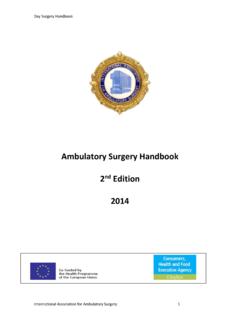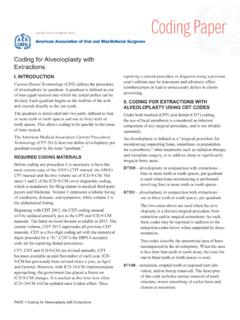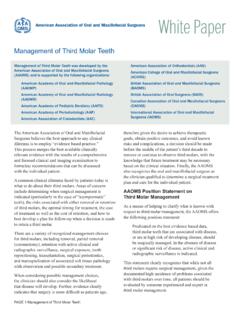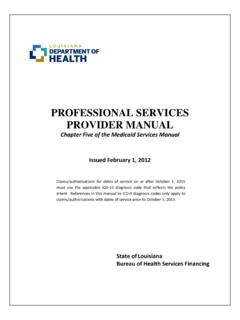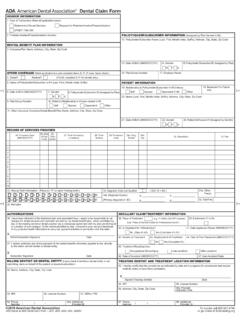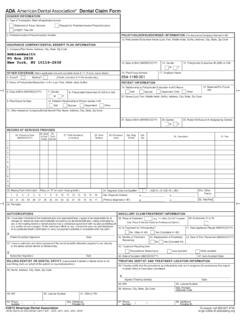Transcription of Day Surgery Handbook - IAAS Homepage
1 Day Surgery Handbook International Association for Ambulatory Surgery 1 Ambulatory Surgery Handbook 2nd Edition 2014 Day Surgery Handbook International Association for Ambulatory Surgery 2 Contents Foreword .. 6 Introduction .. 7 Design of ambulatory Surgery facilities .. 10 Self contained - Free-standing .. 10 Office based Surgery .. 10 Integrated .. 11 Day ward-dedicated theatre(s) in main theatre complex .. 11 Ambulatory ward-no dedicated theatres .. 11 Organisational aspects .. 13 Clinical Lead .. 13 Nursing Lead .. 13 Operational Group .. 13 Pre-operative assessment .. 14 Social .. 15 Medical .. 15 Age .. 15 Blood Pressure .. 15 Body Mass Index (BMI) .. 16 Sleep Apnoea .. 16 Diabetes Mellitus .. 16 Patient information .. 18 Procedures suitable for ambulatory 19 Day of admission.
2 20 Perioperative Management .. 20 Pain control .. 20 Infiltration anaesthesia .. 20 NSAIDS .. 20 Paracetamol .. 21 Regional Anaesthesia .. 21 Recovery Process .. 22 First Stage Recovery .. 22 Second Stage Recovery .. 22 Environment .. 22 Hints and tips .. 23 Patient discharge and support .. 24 Discharge analgesia .. 25 Objective .. 25 Day Surgery Handbook International Association for Ambulatory Surgery 3 Drugs .. 25 Paracetamol .. 25 NSAIDs .. 25 Opioids .. 25 Local Anaesthesia .. 26 Topical anaesthesia .. 26 Supply of analgesic drugs .. 26 26 Monitoring Quality use of audit and standards .. 27 Monitoring .. 27 Telephone follow up service .. 28 Appendix A .. 29 The double Role of the anaesthesiologist in Day Surgery Units (DSU): a possible organization model for running an Day Surgery Department .. 29 Appendix B .. 35 Patient Information Provision: Guidelines and a practical application toolkit.
3 35 Introduction .. 35 Criteria for Patient Information Provision .. 35 Categories of Information .. 38 Phases of Information .. 38 Paediatric Day Surgery .. 41 Guidelines for Construction of Information Packets .. 41 Questionnaire .. 44 Examples of information leaflets .. 45 General information leaflet for day Surgery patients .. 46 Information leaflet for Caregivers .. 51 Procedure Specific Information leaflet .. 54 DAY Surgery Questionnaire .. 57 Links to examples of Patient Information for Day Surgery and Guidelines for Written Material Construction .. 61 Appendix C .. 62 INFORMED CONSENT .. 62 Appendix D .. 65 Day Surgery Procedures .. 65 .. 65 GENERAL Surgery .. 65 BREAST Surgery : .. 66 GYNAECOLOGY .. 67 Day Surgery Handbook International Association for Ambulatory Surgery 4 OPHTHALMIC Surgery .. 67 ORAL AND MAXILLOFACIAL Surgery .. 67 ORTHOPAEDIC Surgery .
4 67 PAEDIATRIC 68 PLASTIC Surgery .. 69 UROLOGY .. 69 VASCULAR Surgery .. 69 Appendix E .. 70 Preventive pain and PONV strategies to optimize quality of care for the day case patient.. 70 Pain Management .. 70 Prevention of Post Operative Nausea and Vomiting .. 71 Appendix F .. 73 Chapter Quality / Clinical Indicators .. 73 Introduction .. 73 Clinical Indicators .. 73 Rationale for using different dimensions Indicators of performance in day Surgery .. 78 Input Indicators .. 78 Access Indicators .. 78 Process Indicators .. 79 Output Indicators .. 79 Outcome indicators .. 79 Patients Safety Indicators .. 80 Cost / Productivity Indicators .. 80 Patients Satisfaction Indicators .. 81 Conclusion .. 81 Appendix G .. 83 Establishing a formal Association: .. 83 Health care system in India: .. 83 Need for an Association: .. 83 How to go about it: .. 84 Challenges faced.
5 85 International exposure: .. 86 Future Plans: .. 86 Appendix H .. 87 PRE-OPERATIVE ASSESSMENT AND EDUCATION .. 87 Social assessment .. 87 Medical Assessment .. 87 Recovery .. 89 Day Surgery Handbook International Association for Ambulatory Surgery 5 Discharge .. 90 Post Discharge Follow Up .. 90 Competencies .. 90 Day Surgery Handbook International Association for Ambulatory Surgery 6 Foreword This Handbook was prepared to support the IAAS Train the Trainers programme. Many people have contributed to this publication and I thank them for their support with this project. In particular it is important to recognise the work of Carlo Castoro, Doug McWhinnie, Paulo Lemos, Jan Eshuis and Gamal Mohamed in the development and delivery of the Train the Trainer courses. My hope is that this is just a beginning and that as the course develops then so will the materials available to support this important work.
6 Please note the Handbook is available online at where we have also provided a forum where you can ask questions about any issues you are facing in day Surgery . Ian Jackson President This Handbook arises from the IAAS 2014 WORK PLAN CLOSING THE GAP, which has received funding, in the form of an operating grant, from the European Union, in the framework of the Health Programme. Contributors Ian Jackson President Jan Eshuis Honorary Secretary Luc Van Outryve Honorary Treasurer Gamal Mohamed President Elect Carlo Castoro Immediate Past President Paulo Lemos Past President Arnaldo Valedon Douglas McWhinnie Gamal Mohamed Jan Jakobsson Sven Felsby Naresh Row Day Surgery Handbook International Association for Ambulatory Surgery 7 Introduction Day Surgery or Ambulatory Surgery has many definitions across the world, the IAAS recommend the descriptor Ambulatory Surgery defined as an operation/procedure, excluding an office or outpatient operation/procedure, where the patient is discharged on the same working day.
7 Another important group are those patients who can be managed with an overnight stay which we suggest should be known as Ambulatory Surgery Extended Recovery Patient defined as a patient treated in ambulatory Surgery / procedure centre/unit, free standing or hospital based, who requires extended recovery including overnight stay, before discharge the following day . Table 1. IAAS Definitions When comparing international ambulatory Surgery rates for a particular operation it is important to realise that despite our recommendations definitions can still be different around the world. Some countries consider a stay of less than 24 hours as Ambulatory Surgery . Given the international contributions to this Handbook the terms day Surgery and ambulatory Surgery will be used interchangeably throughout this Handbook . Day Surgery Handbook International Association for Ambulatory Surgery 8 Day Surgery is not new and indeed in 1909 James Nicoll reported his work on nearly 9,000 children who underwent day Surgery for such conditions as harelip, hernia, talipes and mastoid disease at the Royal Hospital for Sick Children in Glasgow.
8 This was the work of a gifted enthusiast who was quite simply years ahead of his time, even in those early days he stressed the importance of suitable home conditions and co-operation with General Practitioners. Three main factors are driving the increase in day Surgery 1. Changes in clinical practice length of stay following Surgery have been steadily reducing over the past decade and this has been accelerated with enhanced recovery programmes that encourage early mobilisation. 2. Advances in both anaesthesia and surgical techniques have made an expanding number of procedures suitable for day Surgery . These advances have also allowed us to offer day Surgery to patients who were previously deemed unsuitable due to various co-morbidities. Many hospitals are now moving towards a default option for day Surgery for many operations. Instead of the surgeon asking Is this patient suitable for day Surgery ?
9 They are now assumed to be suitable and the question is Is there any justification for admitting this case as an inpatient? 3. Countries are struggling to control costs in their health services and the escalation in emergency admissions linked to their aging populations. The ability to treat more surgical patients through less beds means the cost effectiveness of day case Surgery has put this mode of care at the top of political agenda. However it has taken considerable time in many countries to increase day Surgery rates. The reasons for this are complex but it is important that these are considered as those wishing to introduce day Surgery will experience these issues. Lack of day Surgery facilities Day Surgery is possible without the provision of dedicated day Surgery facilities but hospitals that achieve high performance in day Surgery have dedicated units this will be discussed further later in the Handbook .
10 Clinical preference It is important to acknowledge that many surgeons, anaesthetists and nursing staff have a strong preference for inpatient Surgery . Many see day Surgery as minor and less of a challenge or in some countries surgeons fear the loss of control over hospital beds or their ward . Day Surgery Handbook International Association for Ambulatory Surgery 9 Patient preference Staff often say that the patients don t want day Surgery and it is true that in cultures where day Surgery is new that it is important to educate patients on the advantages. When day Surgery is explained to patients then it does not matter which country you are working in the universal finding is that most would prefer to recover in their home surroundings. The expansion of day Surgery entails a change in mind-set in clinicians, nursing staff, managers and the patient.
